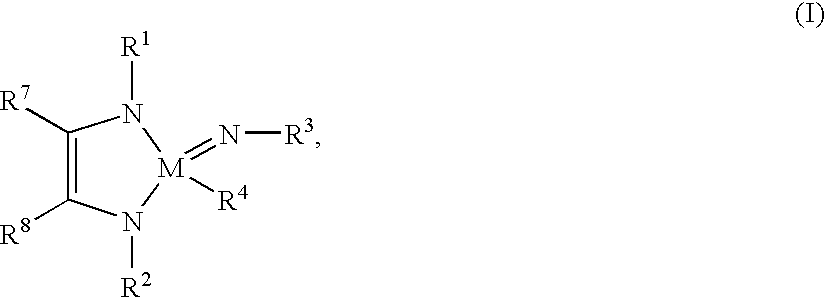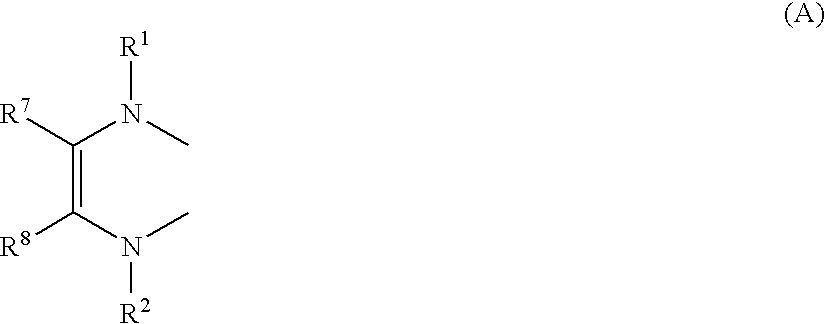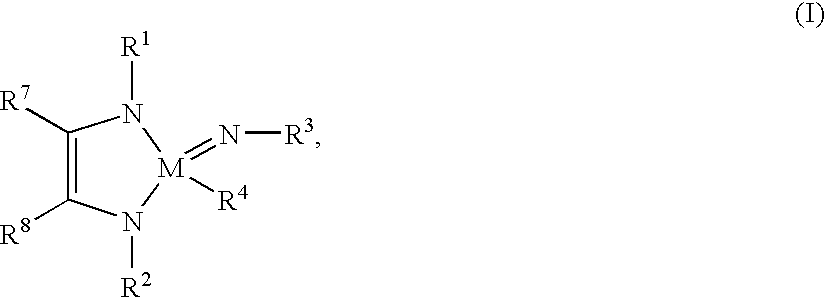Tantalum and niobium compounds and their use for chemical vapour deposition (CVD)
a technology of niobium compounds and chemical vapour deposition, which is applied in the direction of chemical vapor deposition coatings, coatings, azomethine dyes, etc., can solve the problems of difficult control of the individual concentration of elements in the coating, undesirable halogen radicals, and disadvantages of tantalum halides
- Summary
- Abstract
- Description
- Claims
- Application Information
AI Technical Summary
Benefits of technology
Problems solved by technology
Method used
Image
Examples
examples
[0064] In the examples below the abbreviations and abbreviated compound names denote the following structures:
[0065] DtBuAD=1,4-di-tert-butyl-1,4-diazabutadiene
or its divalent radical
[0066]tBu=tert-butyl
[0067]tBuN=tert-butyl imino tBu-N═
[0068] Me=methyl
[0069] Py=pyridine
[0070] Bz=benzyl
[0071] AcAc=monovalent radical of the enolate form of acetyl acetone=
[0072] Cp=cyclopentadienyl
[0073] Ind=monovalent radical of indene
[0074] Dip=2,6-di-isopropyl phenyl
[0075] all=allyl
EXAMPLES FOR THE PRODUCTION OF INTERMEDIATES NOT ACCORDING TO THE INVENTION INTERMEDIATE EXAMPLE A
Production of Li2DtBuAD
[0076] 870 mg (125 mmol) of lithium were added to a solution of 10 g (60 mmol) of DtBuAD in 200 ml of diethyl ether with cooling. After stirring for 8 h at 23° C., the orange-coloured solution was filtered. The solvent was then distilled off at 20 mbar and the residue dried in high vacuum for 48 h. Yield 10.8 g (almost quantitative).
[0077] Analysis:
[0078]1H—NMR (δ against TMS, C6D5C...
example b
INTERMEDIATE EXAMPLE B
Production of [Ta(tBuN)(tBuNH)Cl2.2Py]
[0079] 61.3 ml of tBuNH2 (587 mmol) in 50 ml of CH2Cl2 were added dropwise to a suspension of 21.0 g of TaCl5 (58.7 mmol) in 200 ml of CH2Cl2 with cooling. The reaction mixture was then heated to 23° C. and stirred for 4 h. The suspension obtained was cooled again with an ice bath and a solution of 23.7 ml (294 mmol) of pyridine in 50 ml of CH2Cl2 was added. After stirring for 4 h at 23° C., 150 m of hexane were added to the reaction mixture and the solution obtained was filtered through celite. The residue was washed twice more with 100 ml of CH2Cl2 / hexane 1:1 until it was colourless. The combined solutions were freed from all volatile components at 20 mbar, the residue was washed with hexane and dried. Pale yellow, microcrystalline product, yield 25.9 g (84% of theoretical), melting point >120° C. (decomposition).
[0080] Elemental Analysis Calculated (%) for C18H29N4Cl2Ta (M=553.31 g·mol−1): C, 39.07; H, 5.29; N, 10.13. F...
example c
INTERMEDIATE EXAMPLE C
Production of [(DtBuAD)(tBuN)Ta(μ-Cl)]2
[0084] 43.8 ml of tert-butylamine (418.7 mmol) were added dropwise at 0° C. with stirring to a suspension of 50.00 g of TaCl5 (139.6 mmol) in 300 ml of CH2Cl2. The reaction mixture was heated to 23° C. and stirred for 3 h at this temperature. 23.49 g (139.6 mmol) of DtBuAD were then added and the resulting suspension was stirred for 8 h. The mixture was then filtered following the addition of 150 ml of hexane. The volatile components were removed from the filtrate at 20 mbar and the residue then dissolved in 200 ml of THF. 1.94 g (279.2 mmol) of lithium powder were then added slowly with cooling (immediate dark brown coloration). After stirring for 8 h the solvent was evaporated off at 20 mbar and the residue extracted twice with 150 ml of diethyl ether each time. The solvent was evaporated off from the extract at 20 mbar. The residue was sublimated at 160° C. / 10−4 mbar. Yield: 38.8 g (61% of theoretical), melting point 1...
PUM
| Property | Measurement | Unit |
|---|---|---|
| Electric charge | aaaaa | aaaaa |
| Structure | aaaaa | aaaaa |
Abstract
Description
Claims
Application Information
 Login to View More
Login to View More - R&D
- Intellectual Property
- Life Sciences
- Materials
- Tech Scout
- Unparalleled Data Quality
- Higher Quality Content
- 60% Fewer Hallucinations
Browse by: Latest US Patents, China's latest patents, Technical Efficacy Thesaurus, Application Domain, Technology Topic, Popular Technical Reports.
© 2025 PatSnap. All rights reserved.Legal|Privacy policy|Modern Slavery Act Transparency Statement|Sitemap|About US| Contact US: help@patsnap.com



